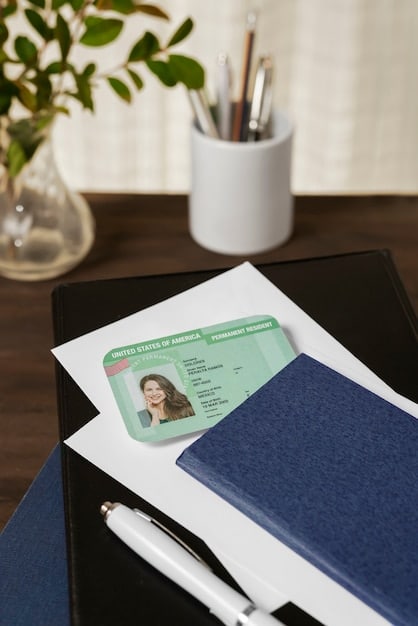How to Apply for Social Security Disability Benefits in 2025

Applying for Social Security Disability benefits in 2025 involves understanding eligibility requirements, gathering necessary documentation, completing the application, and navigating the review process, potentially including appeals if the initial claim is denied, all updated for the latest regulations and procedures.
Navigating the process of applying for Social Security Disability benefits can be daunting, but understanding the steps involved is crucial. This guide provides an insider’s look at how to apply for Social Security Disability benefits in 2025, ensuring you’re well-prepared and informed.
Understanding Social Security Disability Benefits in 2025
Social Security Disability benefits are designed to provide financial assistance to individuals who are unable to work due to a disability. However, it’s essential to understand the eligibility criteria and how the program works in 2025 to successfully navigate the application process.
Types of Disability Benefits
There are two main types of Social Security Disability benefits:
- Social Security Disability Insurance (SSDI): This is for individuals who have worked and paid Social Security taxes. The amount of SSDI benefits is based on your earnings history.
- Supplemental Security Income (SSI): This is a needs-based program for individuals with limited income and resources. SSI is not based on work history.
Understanding which type of benefit you may be eligible for is the first step in the application process. SSDI requires a work history, while SSI focuses on financial need. Ensure you meet the specific criteria for each program before proceeding.

The Social Security Administration (SSA) also has specific definitions of what constitutes a disability. The disability must prevent you from doing work you did before and must also prevent you from adjusting to other work because of your medical condition(s). Your disability must also be expected to last for at least one year or result in death.
In conclusion, understanding the landscape of Social Security Disability benefits in 2025 involves knowing the difference between SSDI and SSI, as well as the stringent definition of disability that the SSA applies. This knowledge is the foundation for a successful application.
Determining Your Eligibility for Disability Benefits
Before starting the application process, it’s crucial to determine whether you meet the eligibility requirements for Social Security Disability benefits. This involves assessing both medical and non-medical criteria.
Medical Eligibility Criteria
To be medically eligible, you must have a medically determinable physical or mental impairment that:
- Prevents you from doing basic work activities (such as walking, sitting, and remembering).
- Has lasted or is expected to last for at least 12 months, or is expected to result in death.
The SSA uses a “Listing of Impairments” (also known as the Blue Book) to evaluate medical conditions. Your condition must meet or equal the criteria in the Listing to be automatically approved. Even if your condition doesn’t meet a listing, you may still be approved based on your Residual Functional Capacity (RFC).
Non-Medical Eligibility Criteria
Non-medical eligibility criteria vary depending on whether you are applying for SSDI or SSI:
- SSDI: You must have a sufficient work history, meaning you’ve worked enough years and earned enough credits. The amount of credits needed depends on your age.
- SSI: You must have limited income and resources. The income limits change annually, so it’s essential to check the current limits for 2025.

Make a detailed assessment of your medical condition and work history or financial situation. Gather medical records, work history documentation, and financial statements to support your claim. Contact the SSA directly for clarification on specific eligibility questions.
In summary, determining your eligibility for disability benefits requires a thorough understanding of both medical and non-medical criteria. By carefully assessing these factors and gathering the necessary documentation, you can increase your chances of a successful application.
Gathering Necessary Documentation for Your Application
One of the most critical steps in applying for Social Security Disability benefits is gathering all the necessary documentation. This includes medical records, work history information, and other relevant documents that support your claim.
Medical Records
Comprehensive medical records are essential to demonstrate the severity of your disability. This includes:
- Doctor’s reports and clinical summaries
- Hospital records and discharge summaries
- Laboratory and test results
- Medication lists
Ensure your medical records are complete and up-to-date. Request copies from your healthcare providers and review them for accuracy. Incomplete or inaccurate records can delay or even lead to a denial of your claim.
Work History Documentation
For SSDI applicants, providing accurate work history information is crucial. This includes:
- W-2 forms and tax returns
- Pay stubs
- Information about your employers, including dates of employment and job duties
The SSA uses your work history to determine if you have enough work credits to qualify for SSDI. Provide as much detail as possible about your past jobs, including the physical and mental demands of each role.
For SSI applicants, providing documentation of income and resources is necessary. This includes:
- Bank statements
- Proof of any income, such as pensions or investments
- Information about any assets you own, such as real estate or vehicles
Organize all your documents in a clear and logical manner. Make copies of everything and keep the originals in a safe place. A well-prepared application packet can significantly speed up the review process.
Gathering the necessary documentation for your application requires attention to detail and thoroughness. By compiling complete and accurate records, you can strengthen your claim and improve your chances of approval.
Completing the Application for Disability Benefits
Once you’ve gathered all the necessary documentation, the next step is to complete the application for Social Security Disability benefits. This process involves filling out several forms and providing detailed information about your medical condition, work history, and personal background.
Application Forms
The main forms you’ll need to complete include:
- Application for Social Security Disability Insurance (SSDI) or Supplemental Security Income (SSI)
- Disability Report
- Authorization to Release Medical Information
These forms can be completed online, by mail, or in person at a local Social Security office. The online application is often the easiest and fastest option. Take your time to fill out the forms accurately and completely.
Providing Detailed Information
The Disability Report is one of the most critical forms. It asks detailed questions about your medical condition, including:
- Symptoms and limitations
- Treatments and medications
- Daily activities
Be as specific and detailed as possible when answering these questions. Describe how your medical condition affects your ability to work and perform daily tasks. Provide examples to illustrate your limitations.
The Authorization to Release Medical Information form allows the SSA to obtain your medical records from your healthcare providers. Make sure to list all your doctors, hospitals, and clinics where you have received treatment.
Submitting Your Application
Before submitting your application, review all the forms and documents to ensure everything is accurate and complete. Keep a copy of your application and all supporting documents for your records.
Submit your application online, by mail, or in person. If submitting by mail, send it via certified mail with return receipt requested to ensure it arrives safely. Consider seeking assistance from a disability advocate or attorney to help you with the application process. Their expertise can increase your chances of a successful claim.
Completing the application for disability benefits requires careful attention to detail and a thorough understanding of the required forms. By providing accurate and complete information, you can help the SSA make an informed decision about your claim.
Navigating the Review Process and Potential Denials
After submitting your application for Social Security Disability benefits, the SSA will review your claim to determine if you are eligible. This process can take several months, and it’s not uncommon for initial applications to be denied.
The Review Process
The SSA will review your medical records, work history, and other relevant information to assess your disability. They may also schedule a consultative examination with a doctor or psychologist to evaluate your condition.
The review process typically involves several steps:
- Initial Review: The SSA reviews your application and medical records.
- Disability Determination Services (DDS): A state agency evaluates your medical condition and determines if you meet the SSA’s definition of disability.
- Consultative Examination (CE): If the SSA needs more information, they may schedule a CE with a doctor or psychologist.
Be responsive to any requests from the SSA for additional information or documentation. Attend any scheduled consultative examinations and provide complete and honest answers.
Potential Denials and Appeals
Unfortunately, many initial applications for Social Security Disability benefits are denied. If your application is denied, you have the right to appeal the decision.
The appeals process typically involves four levels:
- Reconsideration: A second review of your application by the DDS.
- Hearing by an Administrative Law Judge (ALJ): A hearing where you can present your case in person to an ALJ.
- Appeals Council Review: A review of the ALJ’s decision by the Appeals Council.
- Federal Court Lawsuit: If the Appeals Council denies your claim, you can file a lawsuit in federal court.
If your application is denied, don’t give up. The appeals process can be lengthy and complex, but with persistence and the right support, you can still obtain the benefits you deserve.
Consulting with a disability advocate or attorney can be invaluable during the appeals process. They can help you gather additional medical evidence, prepare for your hearing, and navigate the legal complexities of the appeals process.
Navigating the review process and potential denials requires patience, persistence, and a willingness to advocate for yourself. By understanding the process and seeking the right support, you can increase your chances of a successful outcome.
Tips for a Successful Disability Application in 2025
Applying for Social Security Disability benefits can be a challenging process, but there are several steps you can take to improve your chances of success. Here are some essential tips:
Start Early
The application process can take several months, so it’s best to start as soon as you become disabled. The sooner you apply, the sooner you can begin receiving benefits if approved.
Be Thorough and Accurate
Provide complete and accurate information on your application. Incomplete or inaccurate information can delay or even lead to a denial of your claim. Double-check all forms and documents before submitting them.
Gather Strong Medical Evidence
Your medical records are the foundation of your disability claim. Gather comprehensive medical records that document the severity of your condition and how it affects your ability to work. Obtain opinions from your doctors that support your claim.
Be Specific and Detailed
When describing your medical condition and limitations, be as specific and detailed as possible. Provide examples of how your condition affects your ability to perform daily activities and work-related tasks. Avoid vague or general statements.
Cooperate with the SSA
Be responsive to any requests from the SSA for additional information or documentation. Attend any scheduled consultative examinations and provide complete and honest answers. Failure to cooperate can jeopardize your claim.
Consider Seeking Professional Assistance
A disability advocate or attorney can provide valuable assistance throughout the application process. They can help you gather medical evidence, prepare your application, and represent you at hearings. Their expertise can significantly increase your chances of success.
Applying for Social Security Disability benefits in 2025 can be a complex and challenging process. By following these tips, you can improve your chances of a successful application and obtain the benefits you deserve. Remember to start early, be thorough, gather strong medical evidence, and consider seeking professional assistance.
| Key Point | Brief Description |
|---|---|
| 📝 Eligibility | Medical and non-medical criteria must be met. |
| 🏥 Documentation | Gather medical records and work history. |
| ✍️ Application | Complete all forms accurately. |
| ⚖️ Appeals | Appeal if your initial claim is denied. |
Frequently Asked Questions
▼
The main types are Social Security Disability Insurance (SSDI), based on work history, and Supplemental Security Income (SSI), a needs-based program.
▼
You must have a medically determinable impairment that prevents you from working and has lasted or is expected to last 12 months.
▼
You need medical records, work history documents, and personal identification. For SSI, financial records are also required.
▼
Yes, you have the right to appeal a denial. The appeals process involves reconsideration, a hearing, an Appeals Council review, and federal court.
▼
Seeking help from a disability advocate or attorney can increase your chances of success, especially if your medical condition is complex.
Conclusion
Applying for Social Security Disability benefits in 2025 requires careful preparation, a thorough understanding of eligibility requirements, and persistence. By following this insider’s guide, you can navigate the application process with confidence and improve your chances of receiving the benefits you deserve.





